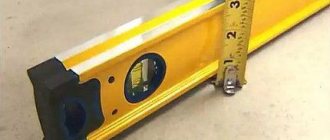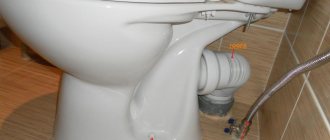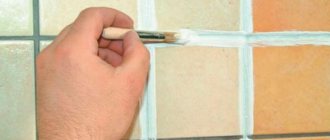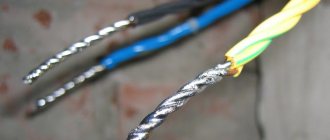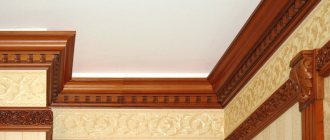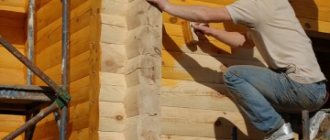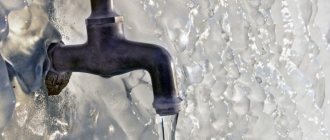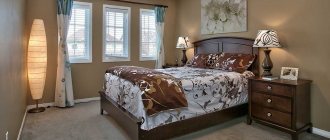Despite its versatility and a lot of positive characteristics, drywall has one specific feature: it is quite fragile under load. As a result, it is recommended to mount the material on a frame with an appropriate number of fixation points.
An example of installing kitchen cabinets on plasterboard. If you do not know the technology for attaching heavy objects to plasterboard, this can lead to deformation and even destruction of the finish. However, taking into account the specifics and choosing the right ways to solve the issue, you can solve the problems that arise with hanging elements on such a fragile material without any difficulties.
Dowel-nails
Installation of a frame for plasterboard begins with fastening the hangers, and then the guide profile to the floor and ceiling. Most often, hangers and profiles are attached to a concrete or brick wall. Less often - to a wooden base, even less often - to plaster. For wood and plaster you need self-tapping screws, we will return to them a little later; for concrete and brick you need dowel-nails. They come in two types and both are suitable for fastening frame parts to a solid base.
Dowel-nails with thread. The simplest and most common option for fastening profiles. To use it, it is enough to have a hammer drill with different modes; in some cases, you can get by with a simple drill or even a screwdriver. Externally, the nails look like a self-tapping screw, but they are exactly a nail; you need to hammer it into the dowel with a hammer and only at the end can you tighten it with a screwdriver. Pay attention to the thread, it is not symmetrical and is shifted towards the head, so it is driven in easily. If necessary, the nail can be unscrewed.
Dowel-nails with thread for fastening plasterboard profiles to walls
Dowel-nails are needed with a size of 6x40mm or 6x60mm, this is quite enough for strong fastening of the guide profiles. It is better to use only on walls and floors. If the holes in the ceiling are loose and the dowel-nails dangle in them, then it would be safer to choose another fastener for the ceiling - a wedge anchor or a dowel-nail for a pneumatic gun.
Dowel nails for a mounting gun. Expensive, but very durable fastening option. For the ceiling, you can use short 18mm dowel nails. Despite the small size, the connection strength is very high.
Cassette with dowel-nails for construction and assembly gun
When driving a nail, it is practically soldered to the concrete due to the high temperature. Such dowel-nails are driven in with a special pneumatic gun. Not every home has such a tool, but the speed of operation and durability are at a high level.
Considering the high cost of the air gun and the dowel-nails for it, the popularity of such fasteners, even among construction crews, is low. Efficiency is excellent, but too expensive.
Hanging kitchen cabinets on drywall - 5 reliable options
Features of attaching wall-mounted furniture to plasterboard are related to the design of the walls and the characteristics of the material itself:
If you make a mistake with the fasteners or choose the wrong fastening method, something like this may happen.
Self-tapping screws
To assemble a frame from profiles, you will definitely need self-tapping screws - for wood, if the frame guides are attached to a wooden surface, and for metal, to fasten different types of profiles together.
Self-tapping screws for fastening the profile frame. Two types of self-tapping screws are excellent for fastening the profile to each other - with a cylindrical head and with a press washer. All threads are small, for metal.
Self-tapping screws with cylindrical head
Self-tapping screws with press washer
These screws can have different coatings, tips, and sizes. Which one you choose is up to you, the difference between them is not fundamental. To assemble the frame, metal screws with a diameter of 3.5 mm and a length of 9.5 mm are used.
Self-tapping screws for fastening plasterboard sheets. To install gypsum board sheets to the frame, you will need self-tapping screws, always with a countersunk head. For a metal frame - fine thread, for a wooden frame - large.
Self-tapping screws for fastening drywall to the frame
The tip can be sharp or with a drill. A self-tapping screw with a drill is used for metal frames with a thickness of more than 0.7 mm. This way the profile does not deform and it is easier to screw in the self-tapping screw.
Method 4. Expandable anchor fastener
Expandable fasteners are more difficult to install, but are much more reliable. When tightened, the part of the dowel located behind the drywall is compressed along its length, spreading widely to the sides. Even a strong accidental tug will not pull the tightened expansion fastener out of the wall.
This approach allows you not only to hang cabinets on gypsum boards, but also to attach pendant elements and lamps to a plasterboard ceiling - one dowel will support a weight of up to 35 kg.
Attention! With multi-point fastening, the load per square meter of drywall should not exceed 50 kg. Therefore, you should not load single dowels to values close to critical.
Expandable anchor fasteners for hollow-core walls consist of two elements:
Two types of expansion fasteners are most often used:
To attach cabinets to drywall, a hole with a diameter corresponding to the diameter of the fastener is drilled in the places marked for fasteners using a conventional drill. It is inserted into the holes in a straight, loose state, and a small side at the end of the dowel will not allow the fastener to fall inside the wall.
After this, a screw or self-tapping screw is screwed into the dowel all the way through the furniture's mounting lugs. There is no need to apply excessive tightening force - overtightening the “butterfly” can lead to the screw turning in the plastic, and the fastening element will have to be changed. It is difficult, but possible, to break the thread on a metal Molly dowel.
Rivets
An alternative to self-tapping screws when installing a frame from profiles can be rivets.
Rivets and riveter
The method is excellent, the rivets hold well, nothing falls off, the head has minimal convexity. But this connection method is used much less frequently; it requires additional tools and more time.
At the stage of installation of the frame, no attachments were made for hanging things
If you plan to use drywall in finishing work, then you need to immediately think about hanging heavy things, because to secure them inside the frame you need to make embedded parts from wood or plywood. Embeds are a reliable guarantee that a TV or shelf will not fall off the wall.
An example of using mortgages to install a TV.
Cutter
A profile cutter is not a fastener, it is a tool. The fastener in this case is the profile itself. The cutter pierces both profiles at the junction, cutting out the retaining whiskers on the reverse side.
Profile cutter for drywall
The cutter has a lot of advantages over self-tapping screws and rivets - there are no costs for fasteners, there are no convex surfaces, the connection occurs instantly, and its strength is fully consistent with the design.
68 tools for working with drywall
Read
Features of a hollow block
This building material has some features. Due to the voids in the rooms, heat is perfectly retained. Using this brick in the construction of a residential building, it is possible to ensure a high level of thermal energy conservation in cold weather. In addition, hollow types of materials have good sound insulation. These types of bricks can withstand various climatic conditions.
The blocks can withstand 40-degree frosts without problems. Hollow brick has a good appearance. The modern market offers a lot of options for facing materials. Products are available in various colors and textures. When building with hollow bricks, there is no need to create deep foundations. This greatly simplifies the work process. This type of brick is much lighter than all other materials. Therefore, even the simplest foundation will support a building made from it. It is very profitable to buy this brick - its price is much lower than solid analogues. If you build from such a block, you can save up to 30% of money. Also, hollow blocks are inexpensive to transport, since their weight is significantly lower than their solid counterparts.
Anchors
A variety of anchors will come to your aid when the walls lack strength, they crumble and crumble when drilled. Or when you need to hang something very heavy on the wall.
Wedge anchor. Not to be confused with a wedge anchor, this is a different type of fastener and is not suitable for a profile. And the wedge anchor, which is shown in the photo, is well suited for attaching pendants to the ceiling.
Wedge anchor for fastening plasterboard guide profile
Most often, threaded dowel-nails are used for ceilings, but they may not be reliable in a vertical position due to the poor strength of the ceiling. The dowel-nail can dangle, and with it the entire frame.
The wedge anchor holds up perfectly even in loose concrete; its design tightly wedges the mechanism so that pulling it back will be a difficult task. In addition, the wedge anchor meets fire safety requirements, since it has no plastic components and is made entirely of metal. For this type of fastener you will need a hammer and hammer.
Anchor bolt. Or a wedge anchor. Anchor bolts are not needed to fasten the frame and plasterboard sheets, but they are perfect for hanging very heavy objects on a plasterboard wall. Boiler, bracket for a large TV, wall cabinet.
Anchor bolt for heavy objects
The anchor bolt is not mounted into the drywall or frame, but into the main wall. It is important to understand that the length of the anchor bolt must be chosen so that most of it is in the main wall and only a small piece of it sticks out from the plasterboard wall. This is the only way it will withstand heavy loads and not break.
The anchor is foldable. Attaches directly to a sheet of drywall rather than to a concrete wall. Folding supports increase the strength of the fastener.
Folding Drywall Anchors
A folding anchor can have different types of pins - a hook, a ring or a screw. The supports can be either folding or tilting. Folding supports are equipped with springs, tilting ones are not.
Folding anchors are useful for not very heavy interior items - shelves, clocks, paintings, mirrors. You can use them to hang a chandelier on the ceiling.
Conclusion
Now we know that attaching heating radiators to a plasterboard wall, as well as installing other heavy objects, is not impossible. I hope that as a result of independently installing heavy objects on plasterboard sheathing, you will receive high-quality and reliable fastening. To make the task easier, I recommend watching the video in this article.
Did you like the article? Subscribe to our Yandex.Zen channel
October 28, 2016
Plasterboard systems, Fasteners, hardware, meshes and membranes
If you want to express gratitude, add a clarification or objection, or ask the author something, add a comment or say thank you!
Dowels
Dowel butterfly. Simple and convenient fasteners for small interior items hung on a plasterboard wall. It got its name because of its shape. Originally sold flat. During installation, the self-tapping screw is screwed in and folds the dowel, increasing the support area and forming a butterfly shape.
Drywall fasteners butterfly dowel
It is mounted in a sheet of plasterboard in a vertical position. To prevent turning, it has special ribs. Requires sufficient space inside the wall. I wrote detailed instructions in an article about the correct installation of a butterfly dowel.
Dowel Molly. Structurally similar to the butterfly dowel, but made of metal. The dowel itself is always the same, but the pin can have different options - a ring, a hook, an angle and a screw.
Types of Molly dowels
When the threaded element is tightened, the body of the dowel turns into a kind of umbrella, resting against the sheet of drywall on the back side.
An example of fastening with a Molly dowel
This increases the support area of the fastener and its reliability. To prevent rotation, the dowel is equipped with spikes.
Dowel Driva. It has both an external conical thread and an internal self-tapping thread. It comes in both metal and plastic.
Types of Driva dowels
Using a sharp drill, it bites into a sheet of drywall and is fixed in it using an external thread. The dowel is screwed in using a screwdriver.
An example of fastening with a Driva dowel
After this, you can screw in the self-tapping screw and hang light objects.
Doubel Hartmut. Knauf fasteners. The threaded element is only a screw.
Doubel Hartmut
The metal support is folded along the plastic guides, inserted into the hole in the drywall, aligned parallel to the wall and secured with a plastic clamp. The extra mustache just breaks off.
Method 2. Mounting a horizontal bus
Sets of modern kitchen sets and wall furniture often include metal rails - a rigid shaped strip with holes and bends for hanging kitchen cabinets on special hooks.
For tires, the universal rule for attaching hanging elements to a plasterboard wall is applied - distribute the load as much as possible along the plane of the sheet and, if possible, transfer it from the plasterboard to the frame.
Installation is carried out in a combined way:
You can find frame elements under drywall using a magnet. To do this, it is held a few millimeters from the surface of the plasterboard - at the location of the metal element, the magnet will be attracted to the metal.
Another way is test drilling. Using a screwdriver with a very thin drill, the plasterboard is drilled without pressure in the places where the profile is supposed to be located. The drilling height is chosen such that the “unsuccessful” holes are subsequently hidden under the tire. The drill easily passes through the gypsum board and “falls” into the void. The drill will rest against the profile and will not drill through the metal without noticeable pressure.
Wooden blocks or planks can be used as tires. In this case, it should be taken into account that the wooden block is noticeably thicker than the metal strip, which is why the wall cabinets will move somewhat away from the wall. To fix this, you will need to install a stop of similar thickness under the bottom edge of the furniture so that the kitchen furniture elements do not hang forward on the wall.
Liquid Nails
The strange name hides ordinary construction adhesive. Glue has little in common with nails and screws, but, nevertheless, it is also present in our selection of fasteners for a reason.
Liquid Nails
Liquid nails can be used to glue various materials, including drywall. To do this, you do not need to build a frame from a profile; the sheets are glued directly to the wall.
Liquid nails are supplied in tubes and are applied using a special gun.
Methods for attaching lightweight objects to drywall
If it is necessary to install elements that do not create a serious load, ordinary self-tapping screws are used. There are two fixation options.
Method No. 1
The simplest technology:
- The area on which it is planned to hang the object is determined.
- Based on the frame diagram, you need to find the nearest rack profiles and jumpers. If you don't have a detailed plan, you can use a large magnet.
- If possible, the position of the element on the surface is adjusted. It is desirable that of the two fastening points, one is on the sheathing part.
- For fixation, special screws are used, which are selected depending on the frame material.
A self-tapping screw screwed into a wall profile can easily support small paintings and other similar objects.
It is more difficult to detect a wooden beam under drywall; for this, you can use tapping.
Method No. 2
This method is not complicated, but does not always guarantee the desired result. Algorithm of actions:
- A hole is drilled into the surface slightly smaller than the shaft of the selected screw.
- The space is filled with elastic putty.
- After the solution has set a little, carefully screw in the self-tapping screw.
- If a small area near the surface is open, then grease it a little.
- After the mixture has completely dried, you can attach a lightweight object to a plasterboard slab.
It is taken into account that this method does not ensure the preservation of the position of the element if it is affected.
On a note! An excellent option is to use a dowel-nail, the sleeve of which is selected according to the thickness of the sheet. An alternative is to create an independent seat from a wooden chopstick.
Planting on a solution, just like the use of conventional dowel-nails, is justified only in the case of fixation on two- or three-layer drywall, but in any case, the maximum for such a suspension is 5 - 7 kg
Profile connectors
In addition to self-tapping screws, rivets, dowel-nails, profiles are joined together using special connectors.
Crabs. Create X-shaped or T-shaped connections of profiles.
Crab profile connector
The crabs have special latches for the profile size. For greater reliability of the connection, it is better to fasten the crab and profiles with self-tapping screws; the crabs also have holes for them.
Extension cords. If you need to increase the profile, this can be easily done using an extension cord.
Profile extension
You join two profiles through an extension and secure them with four self-tapping screws. The connection is ready.
Two-level connector. You will need it if you are planning a two-level frame made of profiles. Its function is to create X-shaped connections at a 90 degree angle.
Two-level profile connector
It goes on sale in unfolded form and, when assembled, is bent into a U-shaped element.
Side connector. Forms a T-shaped profile connection.
Side profile connector
If a side connector is not available for sale, you can use a crab by cutting off one extra side.
Corner connector. Fixes the ends of the profile at an angle of 90 degrees.
Corner profile connector
Supplied flat. Before assembling the frame, the corner is bent at the perforations. Attached to the profile using self-tapping screws.
Kinds
There are several types of dowels that allow you to attach suspended structures to gypsum boards:
- Butterfly.
- Driva plastic or metal screwdriver.
- Molly.
- Fischer dowel.
- KNAUF Hartmut.
- An ordinary dowel-nail.
- Spring-loaded.
Each of these types of fasteners has advantages and disadvantages. To figure out which one is more profitable to use in a specific situation, let’s take a closer look at them.
Tips and tricks from experienced builders
Recommendations on how to secure the dowel part in the wall correctly:
- Pre-clean the funnel where you will insert the self-tapping screw.
- The hole must be deeper than the length of the dowel.
- If the wall is fragile, before installation, wet the plastic part of the fastener with glue.
- If there are voids in the wall, it is advisable to use butterfly fasteners.
- It is advisable to drill the funnel at a slight angle, tilting the drill towards the floor.
- It is advisable to use new drills of the same diameter as the dowel.
- During installation, if complications arise, the fasteners are removed and a wire is used to check what prevents it from going deeper.
- Select fasteners according to the type of wall.
Previous post How to repair a laptop lid mount Next post Installing a hob
